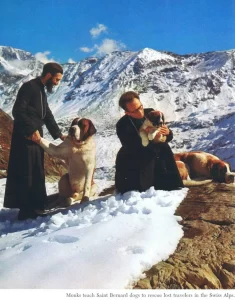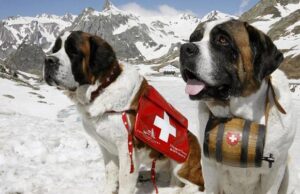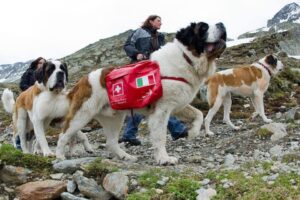 People have been fascinated with Saint Bernard dogs for years. There have been movies made about them, often portraying them as clumsy, drooling pests that “terrorize” homes by making massive messes. Saint Bernards might seem like they are big and clumsy, but for many years, they have been saving lives, and they weren’t clumsy about their work at all. In fact, they were experts at their work.
People have been fascinated with Saint Bernard dogs for years. There have been movies made about them, often portraying them as clumsy, drooling pests that “terrorize” homes by making massive messes. Saint Bernards might seem like they are big and clumsy, but for many years, they have been saving lives, and they weren’t clumsy about their work at all. In fact, they were experts at their work.
In the early 18th century some monks, who were living in the snowy and dangerous Saint Bernard Pass, which is a route through the Alps between Italy and Switzerland, kept these dogs to help them on their rescue missions after bad snowstorms. In fact, the Saint Bernard dogs got their name from the pass where the monks were located. Over a span of nearly 200 years, about 2,000 people, from lost children to Napoleon’s soldiers, were rescued because of the heroic dogs’ uncanny sense of direction and resistance to cold. Of course, there were changes in the dogs through crossbreeding, and finally the dogs became the amazing new breed they are today. While the dogs are amazing as rescue dogs, Saint Bernard dogs are also commonly seen in households today.
The dogs were trained to hunt for people who were lost, and when they found them, the dogs allegedly carried a small cask of liquor around their neck…although, this has not been documented for sure. Then, the dog would lay on top of the victim to keep them warm. Being lost in a snowstorm, often called “white death” could become a death sentence, because hypothermia would soon set in, and the victim would be lost. At a little more than 8,000 feet above sea level, the Great Saint Bernard Pass is a 49-mile route in the Western Alps. The pass is covered with snow for most of the year, and in fact, it is only snow free for a couple of months during the  summer. Throughout history, the route has been a treacherous one for many travelers. Of course, that didn’t stop people from trying to make the trek. An Augustine monk named Saint Bernard de Menthon founded a hospice and monastery around the year 1050, which is how Saint Bernard Pass came into being. Sometime between 1660 and 1670, the monks at Great Saint Bernard Hospice acquired their first Saint Bernards. These dogs were descendants of the mastiff style Asiatic dogs brought over by the Romans. The dogs were to be used as watchdogs and companions. The original Saint Bernards were quite a bit smaller in size, had shorter reddish brown and white fur, and a longer tail.
summer. Throughout history, the route has been a treacherous one for many travelers. Of course, that didn’t stop people from trying to make the trek. An Augustine monk named Saint Bernard de Menthon founded a hospice and monastery around the year 1050, which is how Saint Bernard Pass came into being. Sometime between 1660 and 1670, the monks at Great Saint Bernard Hospice acquired their first Saint Bernards. These dogs were descendants of the mastiff style Asiatic dogs brought over by the Romans. The dogs were to be used as watchdogs and companions. The original Saint Bernards were quite a bit smaller in size, had shorter reddish brown and white fur, and a longer tail.
Travel on the Saint Bernard Pass route was so dangerous, and at the turn of the century, servants used as guides were assigned to accompany travelers between the hospice and Bourg-Saint-Pierre, a municipality on the Swiss side. The trek was even treacherous for them, and by 1750, the guides were routinely accompanied by the dogs, whose broad chests helped to clear paths for travelers. While working with the dogs, the guides soon discovered that the dogs had a tremendous sense of smell, as well as their ability to discover people buried deep in the snow. Soon the dogs were sent out in packs of two or three alone to seek lost or injured travelers. Once they found a lost traveler, one dog would stay with the victim, while the other or others would go back to the hospice to bring help.
 So good were these dogs at their work, that when Napoleon and his 250,000 soldiers crossed through the pass between 1790 and 1810, not one soldier lost his life. The soldiers’ chronicles tell of how many lives were saved by the dogs in what the army had named “the White Death.” So amazing were these dogs, that one, named Barry, that was particularly legendary, who lived in the monastery from 1800-1812, saved the lives of more than 40 people. In 1815, Barry’s body was put on exhibit at the Natural History Museum in Berne, Switzerland, where it remains today. Saint Bernard dogs have proven themselves to be a vital part of mountain rescue operations.
So good were these dogs at their work, that when Napoleon and his 250,000 soldiers crossed through the pass between 1790 and 1810, not one soldier lost his life. The soldiers’ chronicles tell of how many lives were saved by the dogs in what the army had named “the White Death.” So amazing were these dogs, that one, named Barry, that was particularly legendary, who lived in the monastery from 1800-1812, saved the lives of more than 40 people. In 1815, Barry’s body was put on exhibit at the Natural History Museum in Berne, Switzerland, where it remains today. Saint Bernard dogs have proven themselves to be a vital part of mountain rescue operations.


Leave a Reply